My first encounter with Nick Jacobs happened in 1970. I had started to read New Left Review: in those days especially, the journal had an air of discovery about it, and I seemed to read most of every issue. That year, 1970, was when New Left Books was launched. NLR subscribers could buy these books by mail order, at a favourable price.
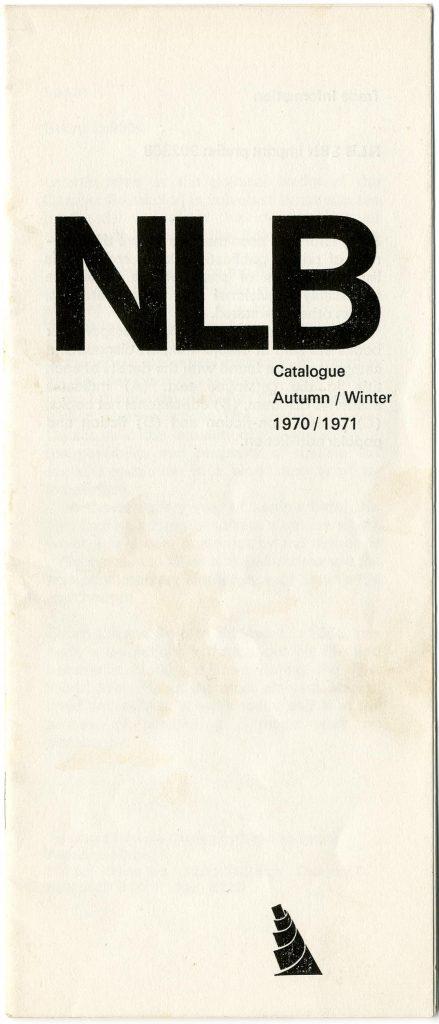
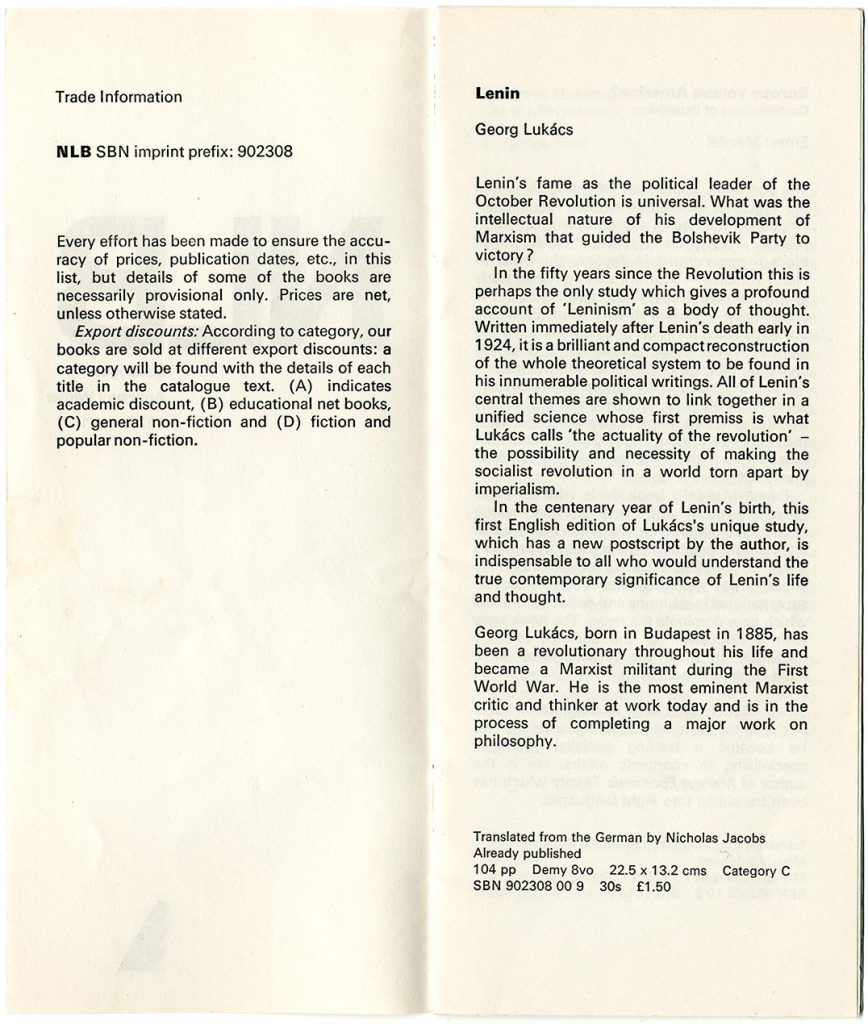

Pages from the first NLB catalogue, 1970 (216 × 92 mm)
New Left Review Editions came without the dust-jacket that the trade NLB editions carried. I bought a copy of one of the first titles issued: Georg Lukács’s Lenin, translated from the West German edition of 1967; its Standard Book Number is ‘000’, indicating that this was the very first of the list to be lined up for publication. My copy has pencil markings, suggesting that I read it all. Just getting seriously interested in typography, I admired the slim format and the elegant series design. The designer Gerald Cinamon was credited. The publisher’s symbol, based on the image of Tatlin’s Monument to the Third International, was, I discovered much later, designed by Ken Garland (soon to become one of my graphic design teachers at Reading). Lukács’s text was translated by Nicholas Jacobs: a name that I began to see occasionally through the 1970s in left-wing publications.
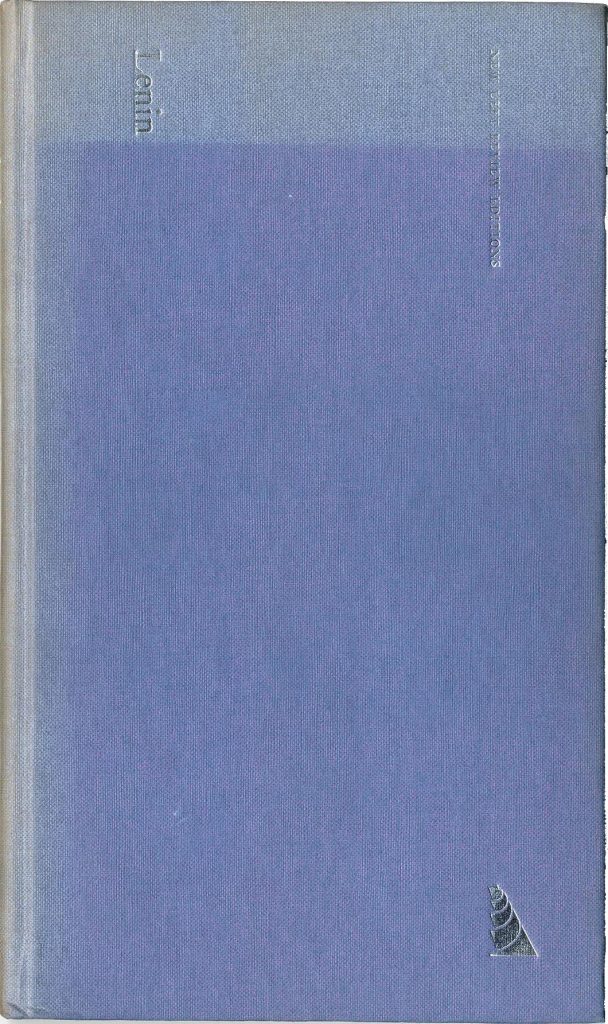
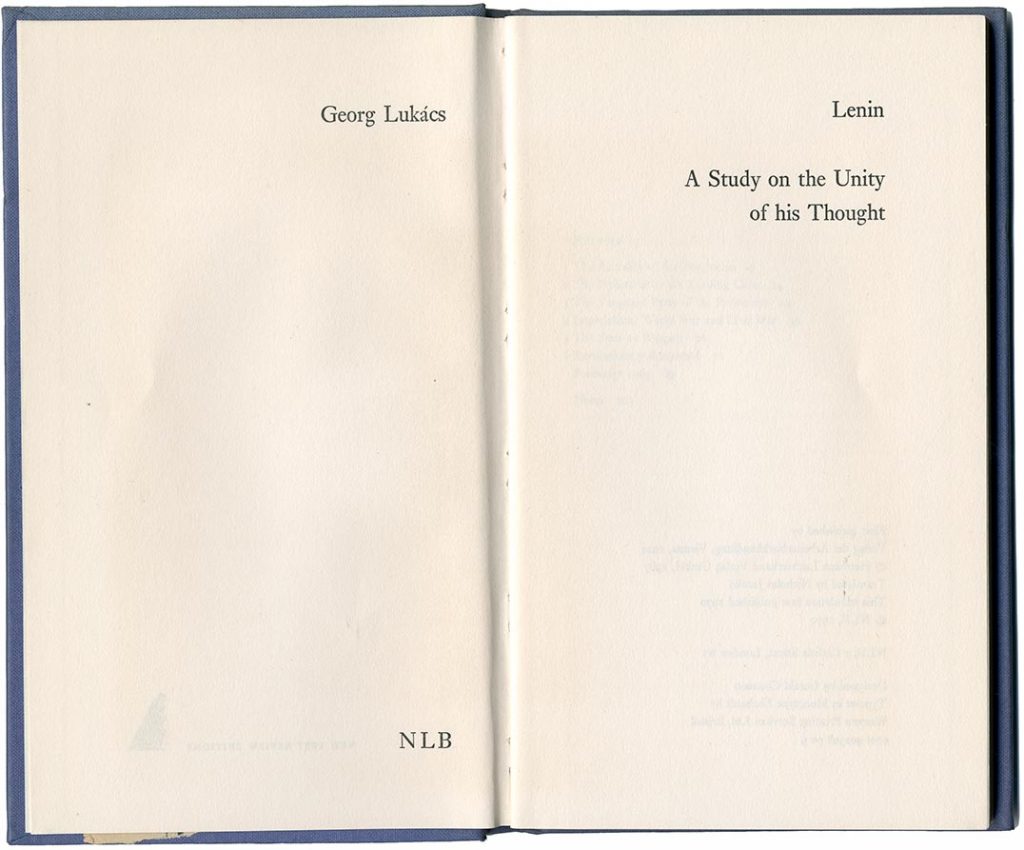
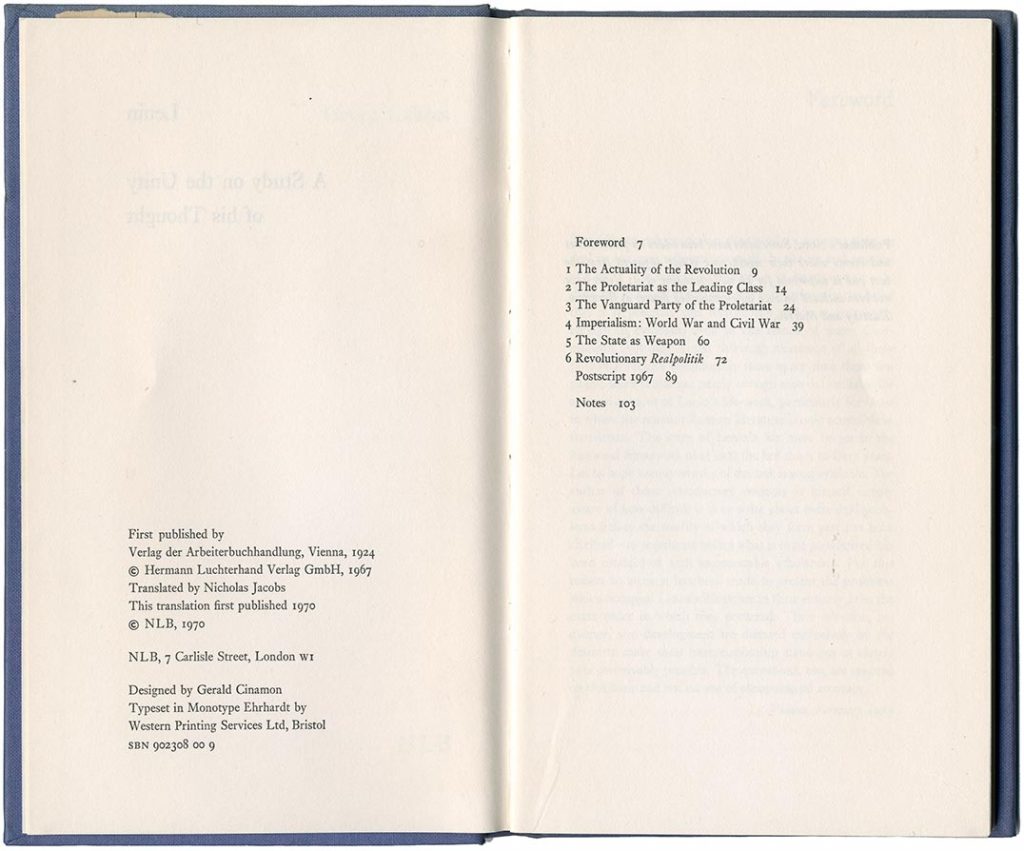
The first NLB book: Georg Lukács, Lenin, 1970 (225 × 132 mm). The cover of this copy is sunburned at the top.
Ten years on, in 1980, Hyphen Press was launched, as a one-book publisher (Norman Potter’s What is a designer), operating from an address in Reading: a thoroughly marginal enterprise. In 1982 I moved to London and gradually worked towards publishing further books. I began to attend the London Book Fair, and remember vividly the astonishment of seeing Libris’s first catalogue in an untended pile (there was no Libris stand at that fair). This was perhaps in spring 1988, because the catalogue is dated October 1987. In both content and design it seemed to come from far outside the British book trade, though the address of the publisher was London NW5 – where I too was living. This catalogue was something else: serious, straightforward, considered. It might have been issued by one of the good small German publishers. The design is uncredited, but it perfectly matched the contents.
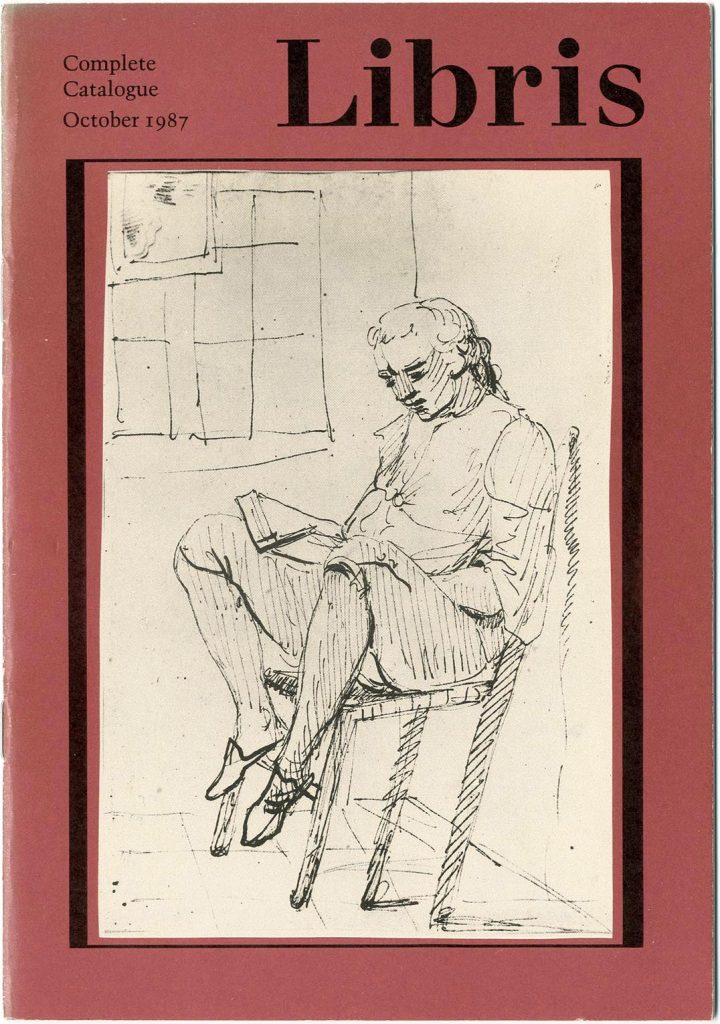
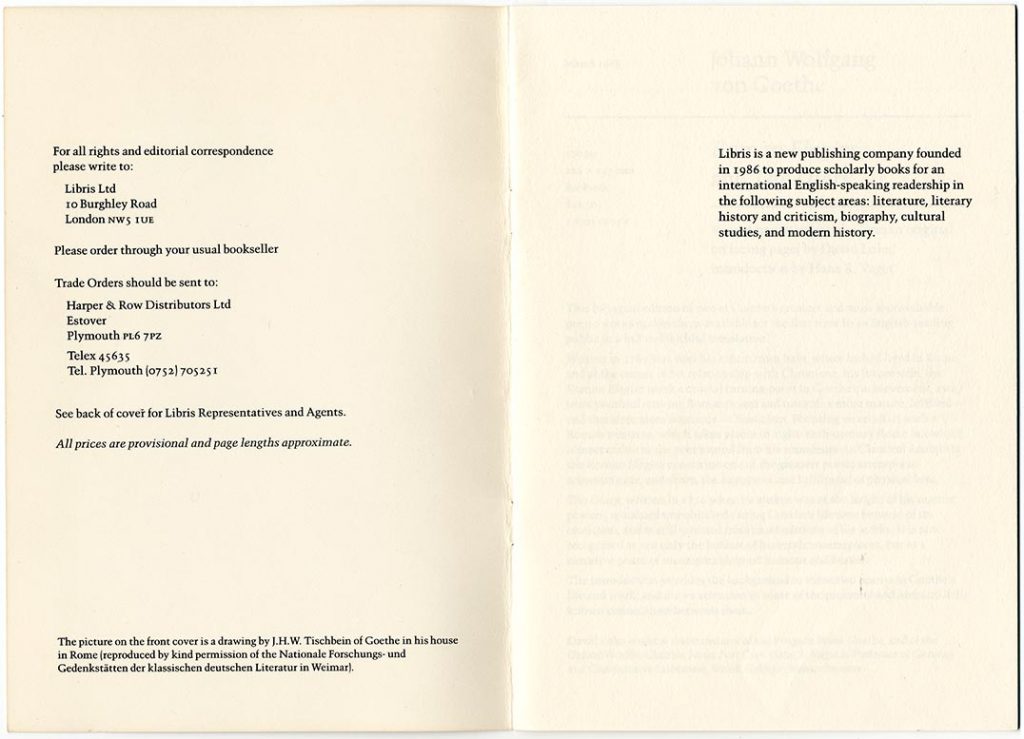
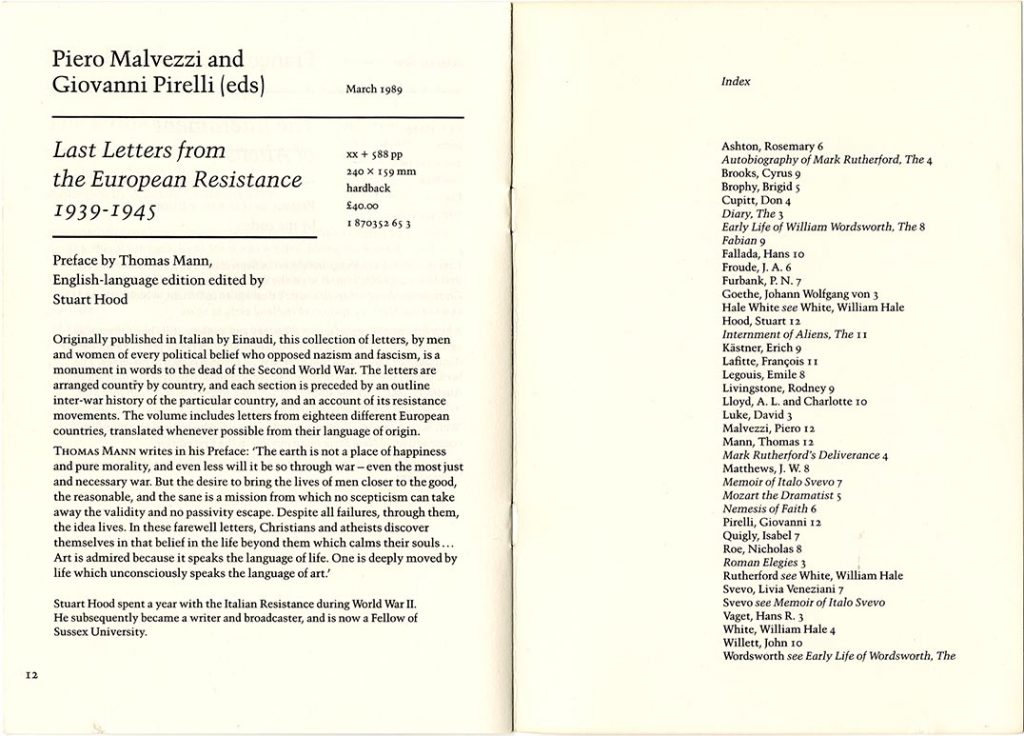
Pages from the first Libris catalogue, 1987 (210 × 148 mm). Notice the index on the last page: translators are included, along with authors and titles. The last letters of the European resistance was announced here, but never published (Stuart Hood was a perfect choice for translator).
Nick had worked on and off in publishing since his late teenage years – first as an apprentice copy-editor at Cassell’s in the 1950s; then as an editor at Penguin Books in the mid-1960s (the Tony Godwin years), then New Left Books; then Lawrence & Wishart, where he was in joint editorial control. So by the time he started his own imprint in 1986, he was a thoroughly experienced editor of books, who also knew enough about the processes of acquiring and securing rights, setting royalty percentages, making co-publishing agreements, managing distribution and representation to the shops.
Nick once told me that he had written the Libris authors’ agreement himself, rather than copy an existing one. Publishing contracts are traditionally mean – sometimes even threatening – towards the author. He wanted an agreement that was fair to both author and publisher. A lawyer to whom he showed his draft had said ‘not bad’, and I gathered didn’t suggest many changes. Such an egalitarian contract, as I discovered too, is also a truer reflection of the processes of the small publisher, in which author and editor-publisher work intimately together.
Libris was a dream that Nick had had for some years. The final kick towards doing it, he said, was given by a chance meeting with Susan Shaw, an old Penguin colleague. A Yorkshire woman with characteristic ‘Yorkshire’ directness, she urged him to get on with it. By then Sue had left Penguins, was running a small press, and owned an impressive printing set-up with Monotype composition, then being junked by the British printing trade. She offered a service for publishers who needed to revise texts for lithographic reprint: she would set the revised and added lines of text, which the publisher could then strip into the old pages, for photographic reproduction. This procedure, known as ‘patching’, was used by conscientious publishers for these few years of transition between letterpress and lithographic printing.
When Norman Potter and I came to make a new edition of What is a designer, in 1989, we used Sue Shaw’s services to adjust the pages of the book we had made in 1980. I stripped in the patching text, which was just different enough in inking to let all the altered lines jump out of the pages, proclaiming ‘these words have been added!’ (It didn’t help that the patched text was set in Monotype Times, while the original text of our book was set in Intertype Times: noticeably different in the structure of certain characters.) At around the same time, Nick was using the same method to re-publish books, and using Sue’s services too. The example I know is the Libris second edition of Brigid Brophy’s Mozart the dramatist. There the patching is invisible.
One of Nick’s most attractive qualities as a publisher was his eye for books that deserved to be re-published. The early books on the list show this clearly. Surprisingly for an imprint that came to be seen as a specialist in German literature, these first publications include two works by nineteenth-century English religious doubters, a book on Wordsworth, one on the French Revolution (seen from below), and a memoir of Italo Svevo. It looks as if these were works he had long wanted to see back out in the world. But they were not cheap pick-ups: all were provided with fresh, critical introductions. New translations are another variety of recuperation: every new translation is a kind of second edition. In this light, the first ten Libris titles were re-publications, and it was only in 1990, with Richard Dove’s He was a German, that Libris began to publish new works.
As well as these simple acts of recovery, Libris’s list included a couple of noble acts of repair: Erich Kästner’s Fabian in an amended translation that restored expurgated scenes; Hans Fallada’s Little man – what now? in a fresh and now uncensored translation. Nick was certainly the pioneer in the recovery of Hans Fallada in English. Although in the 1930s several of the novels had been published in English translation soon after their German publication, it was Libris’s two fresh editions (The drinker [1989] and Little man – what now? [1996]), that led on to Fallada’s recovery in the following years. Libris also commissioned and published Jenny Williams’s biography of Fallada (More lives than one, 1998). Then in the 2000s Melville House in New York picked him up, and finally – following the initiative of brave independent publishers – Penguin Books took over.
Post-Libris, Nick contributed to Penguin’s new editions of Fallada’s Once a jailbird, Wolf among wolves and Iron Gustav, which completed the English translations that had been issued in abbreviated form in 1934, 1938 and 1940 (respectively). He said then, with characteristic quiet humour, that he had become a specialist in these repair jobs.
Nick had a discerning eye for the quality of translation. His ideal was a text that could be read as idiomatic English, while remaining faithful to the original. I remember that he disliked the few lines of Brecht’s Dreigroschenoper that I had translated as an epigraph for my Froshaug book. ‘Why didn’t you take the good existing translation?’ I suppose I had wanted to avoid any question of copyright. But also I was remembering Anthony Froshaug’s own habit of making rather literal translations. My unformulated, probably naive ideal was rather a text in which one could be aware of the movement of the original behind the English text. Among the translators from German that he employed were some of the most brilliant of those years: David Luke (on several occasions), John Willett, Edmund Jephcott, Susan Bennett, Rodney Livingstone.
The last book that he published (in 2009), Erdmut Wizisla’s Walter Benjamin and Bertolt Brecht, was translated very ably by Christine Shuttleworth, who also made the index. Though I don’t think that this was intended as a finale for Libris, it did come to seem so, in that it brought together two of Nick’s essential figures in the pantheon of modern German culture. By then, and typically for Nick’s publishing work, the author Erdmut Wizisla had become a personal friend of his publisher. I wrote an analysis of this book in an earlier post on this website, arguing that the English edition makes an editorial transformation that lifts it above the original Suhrkamp edition, which was too much an unconverted version of Wizisla’s doctoral thesis.
One of several of my learnings from Nick was to ask Christine Shuttleworth to take on translation and indexing work for Hyphen Press. The most demanding of these jobs was the translation of O.F. Bollnow’s Mensch und Raum, which she put into lucid English.
As an editor, Nick worked in service of the reader. His Libris books, in their editing and design, were pleasant to read and use. He liked maps as aids to understanding the content – for example in Jenny Williams’s biography of Hans Fallada, where a map of Fallada’s Germany is used on the end-papers. He liked lists of characters, as one finds in a playscript – but he provided them also for novels. Libris books offered readers a certain comfort and reassurance in their structuring and form, if not always in their content.
Libris used two designers, at first working in partnership: Cinamon–Kitzinger. Nick had known Gerald or Jerry Cinamon at Penguin Books, where he was chief designer. Cinamon had come to Britain from the USA, where he had been educated in the Swiss-European manner, though he could also work in the tradition of Penguin-era Tschichold.1 Tony Kitzinger had learned typography at the University of Reading and had worked for London publishers, notably Chatto & Windus. The first Libris books carry the joint credit, though one can discern the differences of style: the modernist Cinamon and the more traditional Kitzinger. Later they parted ways, and it was Tony Kitzinger with whom Nick continued to work, and who also became a co-director of the Libris company. Incidentally both of them had backgrounds that enhanced their sympathies towards Nick’s publishing: Cinamon’s family background was in Jewish east Europe; Kitzinger is the son of Ernst Kitzinger, the eminent historian of Byzantine art, who had in 1934 come to Britain from Germany.
From letters and notes that we wrote each other, it seems that I first met Nick in 1993 at a conference. Quite soon we began to have lunch together regularly. Later I brought him along to a weekly lunch group with a small group of friends, and he became a constant member of this Friday lunch group until becoming seriously ill last December. We came to each other’s book launches, showed each other newly arrived copies before publication.
Perhaps the highpoints of our friendship came when, at his suggestion, we shared a stand at the London Book Fair. This was in 1998. For both of us this was a new experience: our stand was the smallest available and could hardly accomodate two people; it was also in an annexe to the main hall of Olympia and was visited only by the committed. But we had a good time talking together for three days. The next year, 1999, we did it again, this time taking slightly larger premises. For my part it felt good to sit alongside a publisher of serious literature, and to escape from the flimsy world of design and books-about-books. We should really have gone on to do this at the Frankfurt Book Fair: relatively cheaper than London’s fair, and a more sympathetic venue for the kind of books that Nick was doing and to which I was aspiring.2
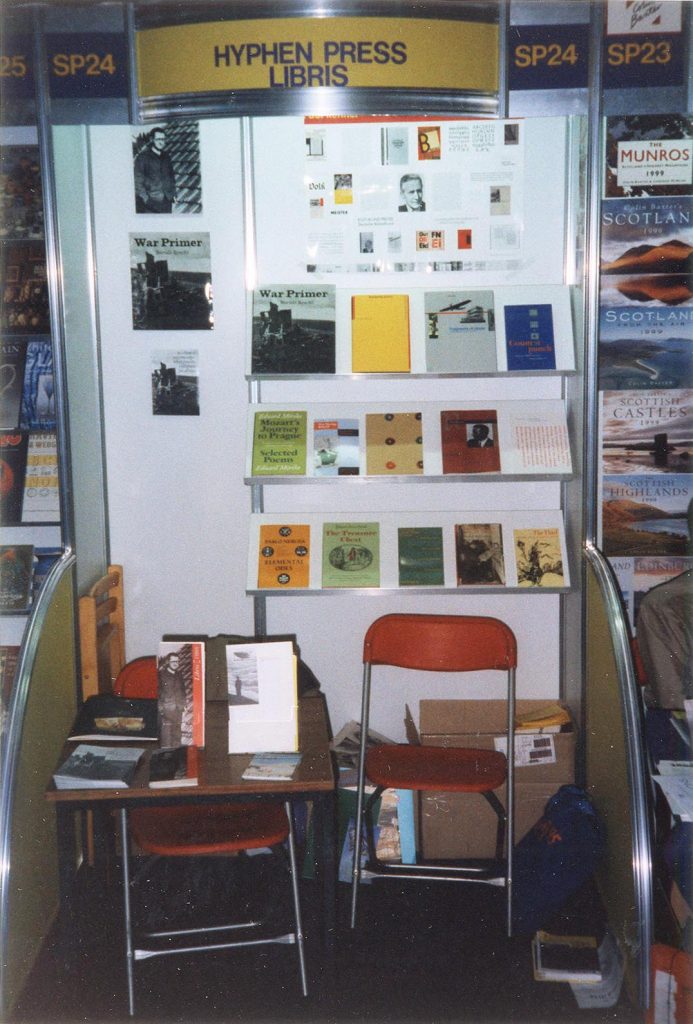
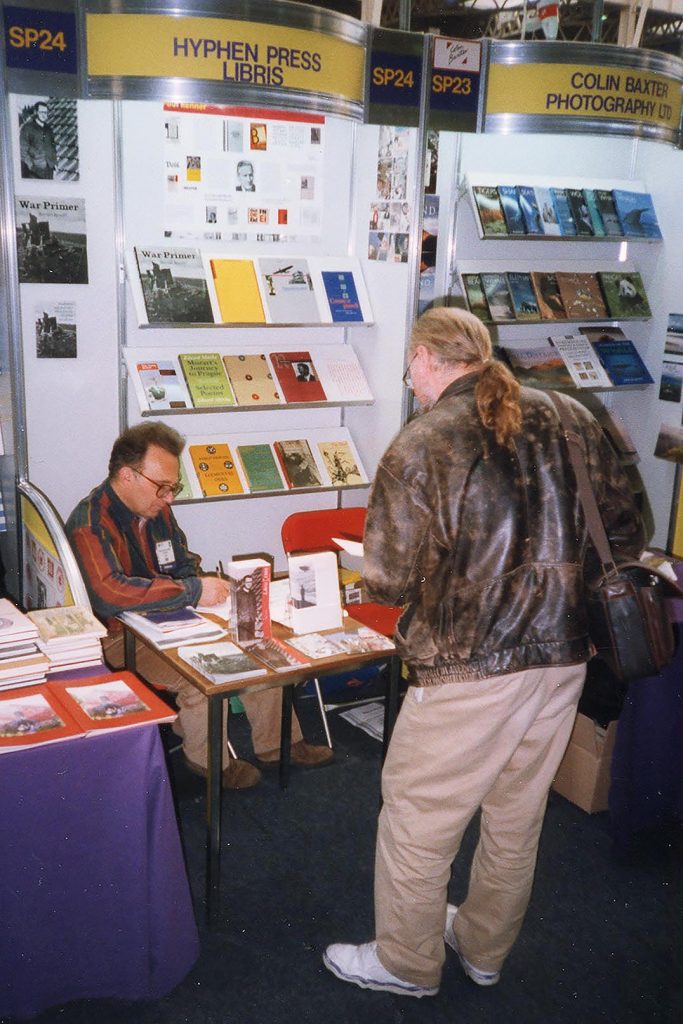
London International Book Fair, Olympia, 1998

London International Book Fair, Olympia, 1999: Nick in the book trade.
Nick belonged, even more than I did, to the old book trade that had existed before the online sellers, before social media, before pop-ups, before print-on-demand, before risograph printing. As to ‘online’: rather late in the day, I found a designer to make a Libris website for him, but he never made full use of that site. Its domain name was not renewed and the URL was then seized by some dubious enterprise.
In 2020 Nick asked again for my help in getting a website made. He said that he wanted to publish his occasional writings there, following the example of the book I had made of the essays and articles of our common friend Tanya Harrod. But he balked at the price, and I think he doubted his own impulse for this – perhaps it was just vanity? This must have been the same modesty and self-effacement that forbade any mention of himself in his Libris books (contrast this with the effusive, performative thanks that authors now shower on their editors and publishers in the acknowledgements). Towards the end of last year, when I suppose he knew he was seriously ill, he asked me again if I could help to get a website done. This time I could feel the urgency and decided to do it myself with a WordPress site. Unilaterally I made it a website for both Nick’s complete occasional writings, and for his publishing firm – Libris. It is here.
————————————————————
Robin Kinross
————————————————————
Notes
- Jerry Cinamon (1930–2024) died on 17 February this year, the day after Nick.
- A little later, Nick did book a stand for Libris at Frankfurt, but at the last moment decided not to go; I suppose he was overtaken by a loss of confidence. I remember the desolate, empty space where the stand should have been.